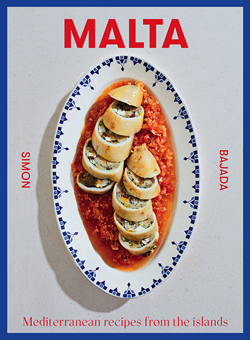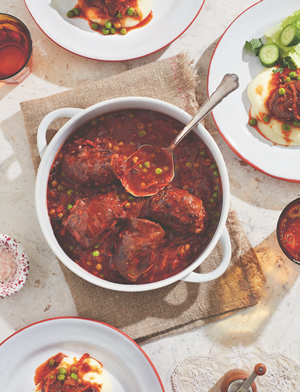By Christine Salins.
 I adore Malta, a country I’ve been fortunate enough to visit twice. I love its layers of history, its beautiful Mediterranean landscape and lifestyle, its wonderful cuisine, and that it has one of the world’s most beautiful harbours.
I adore Malta, a country I’ve been fortunate enough to visit twice. I love its layers of history, its beautiful Mediterranean landscape and lifestyle, its wonderful cuisine, and that it has one of the world’s most beautiful harbours.
Yep, it’s a country I could happily spend a lot of time in. In the meantime, I’ll content myself with a copy of Simon Bajada’s beautiful new cookbook, Malta (Hardie Grant Books, $45) which is not only an ode to Maltese cuisine but has lovely snapshots of the country and its people.
Because of its location, south of Sicily and east of Tunisia, this outcrop in the Mediterranean has been a haven and a crossroads influenced by numerous cultures and occupations, all of whom have left their mark on the Maltese kitchen.
Bajada, who grew up in Adelaide but has Maltese heritage, argues that this unique culinary legacy makes Maltese cooking the most intriguing ‘minestrone’ of Mediterranean cuisine.
Now living in Sweden, his previous cookbooks were concerned with Scandinavian cooking – The New Nordic (2015), Nordic Light (2016), and Baltic (2019) – so it’s great to see him turning his attention to the cuisine of his own family heritage.
In Malta, he demonstrates that the joy of Maltese cuisine is that it isn’t so exact … that you can let go of the dogmatic methods you might expect of other Mediterranean cuisines and inject some of your own taste into the dishes.
Bringing a freshness to many classic Maltese recipes, he captures the essence of the cuisine and shines a light on quality produce – simple fare with ingredients that are grown and cooked well, resulting in something that is unexpectedly glorious.
Included in the line-up are recipes such as ftira, a sourdough bread drenched in tomato, tuna and olives; aljotta soup, a flavour-packed brew of fish and garlic; stuffed artichokes; anchovy fritters; pastizzi, a deliciously addictive pastry; and Prinjolata, a decadent cake studded with nuts and glacé cherries.
The recipe here is a Maltese staple. Note that it does not actually contain olives. The word ‘olive’, referring to sliced meat encasing a stuffing, is derived from an old French word ‘alou’, meaning lark. The shape of the meat rolls was thought to resemble these birds without their heads.
For celebratory occasions, Maltese families are sure to grace the table with bragioli (beef olives). Each household has its own version, with some using boiled eggs in the stuffing, and others braising the olives in tomato ragu or adding spice.
“My recipe honours the dish’s fundamentals, using old bread and smoked pork, and peas to finish the sauce,” says the author. “Serve bragioli with boiled or mashed potatoes and a salad. The sauce is traditionally enjoyed over spaghetti as an entree.”
 Bragioli (Beef Olives)
Bragioli (Beef Olives)
Serves 4 to 6
BEEF OLIVES
250 g minced pork
250 g minced beef
100 g smoked speck, diced (or use bacon)
1 onion, finely diced
2 garlic cloves, finely chopped
50 g fresh breadcrumbs, or torn bread without crusts from a continental-style loaf
50 g parmesan, grated
2 tablespoons chopped flat-leaf (Italian) parsley
salt and pepper
8 large thinly cut topside or round beef steaks (around 600 g)
1 tablespoon olive oil
SAUCE
1 onion, chopped
2 garlic cloves, finely chopped
1 medium carrot, grated
1 tablespoon olive oil
2 tablespoons tomato paste (concentrated purée)
250 ml red wine (a slightly sweet wine works well)
250 ml beef stock
2 bay leaves
salt and pepper
150 g peas, rinsed if frozen
To make the stuffing, combine the minced meats, speck, onion, garlic, breadcrumbs, parmesan and parsley in a large bowl. Season well with salt and pepper and mix thoroughly.
Using a mallet or heavy glass bottle, pound the steaks between pieces of plastic wrap until 5 mm–1 cm thick. Thinner is better, but be careful not to tear the meat.
Take an eighth of the filling and place it in the middle of a flattened steak. Fold one end of the steak over the filling, tuck in the sides, and roll up. Secure with toothpicks or tie with kitchen string and place on a plate seam-side down. Continue to make rolls with the remaining steak and stuffing. Season the rolls on both sides.
Heat a heavy-based frying pan over a medium heat and add the oil and beef olives. Gently colour them on two sides, then transfer to a plate.
In the same pan, begin the sauce by sautéing the onion, garlic and carrot with the olive oil over a medium heat. Cook for 5 minutes without browning, then add the tomato paste, wine, stock, bay leaves, some salt and pepper and the beef olives. The liquid should come at least a third of the way up the beef (top up with water if needed). Place a lid or foil over the pan and simmer over a low heat for 1 hour. Turn the olives after 30 minutes and check the liquid level, adding water if necessary. Finish with the peas, cooking for a few minutes more. Remove from the heat and allow to sit for 10 minutes before serving.
Recipe and image from Malta by Simon Bajada, photography by Simon Bajada. Published by Hardie Grant Books, RRP $45.00.



